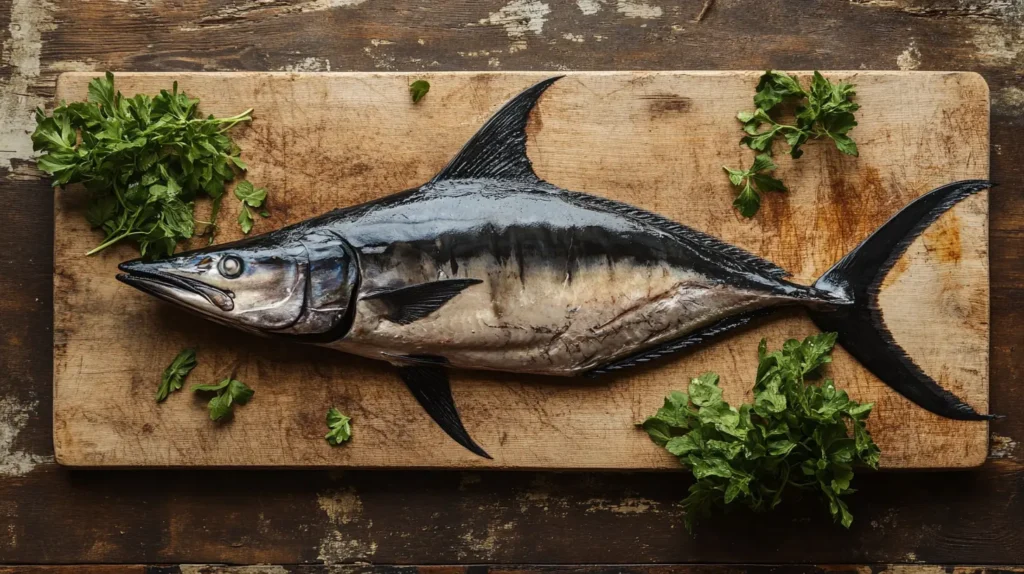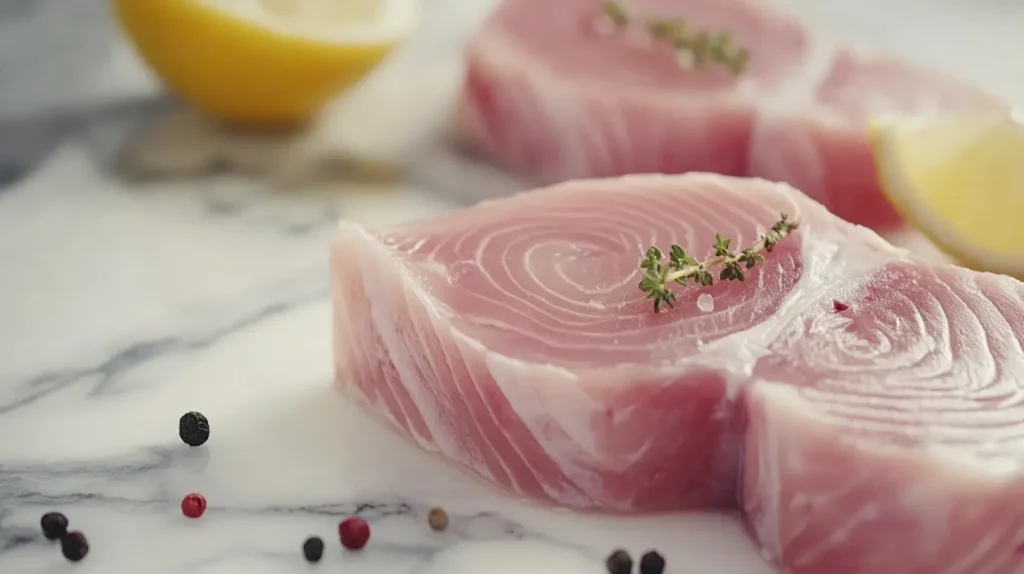Introduction
Swordfish meat is a prized delicacy in the seafood world, known for its firm texture, rich flavor, and versatility in cooking. As a sought-after fish in both fine dining restaurants and home kitchens, swordfish has carved out a reputation as a premium choice for seafood enthusiasts. Its ability to hold up well on the grill, in the oven, or even as sushi-grade servings makes it incredibly popular among chefs and food lovers.

This article dives deep into the world of swordfish meat, exploring why it’s such a beloved seafood option, its taste and color, affordability, and whether it’s considered a “fishy” fish. Additionally, we’ll cover its nutritional value, health benefits, and practical tips for cooking and storage to help you enjoy swordfish to the fullest.
Why is Swordfish So Popular?
Swordfish has earned its popularity for several compelling reasons. From its unique texture to its nutritional benefits, this fish satisfies both culinary preferences and health-conscious diets.
Culinary Versatility
Swordfish is incredibly versatile when it comes to preparation. Its dense, meaty texture makes it perfect for grilling, baking, and searing. Unlike flakier fish that may fall apart during cooking, swordfish holds its shape, making it ideal for kebabs, steaks, and skewers.
Its adaptability also allows chefs to experiment with marinades, sauces, and seasonings. Whether you prefer Mediterranean herbs, Asian-inspired glazes, or spicy rubs, swordfish pairs well with a wide range of flavors.
Rich Flavor and Texture Appeal
Swordfish meat stands out because of its mildly sweet, buttery flavor. It has a firm, steak-like texture that is more substantial than most fish, giving it a satisfying mouthfeel. This makes it particularly appealing to those who may not typically enjoy seafood but appreciate a meatier bite.
Because of its distinct flavor, swordfish can be the star of the plate without needing heavy sauces or seasonings. A simple lemon and garlic marinade or a drizzle of olive oil can enhance its natural taste.
Health and Nutritional Value
Swordfish isn’t just delicious—it’s also nutritious. It’s packed with lean protein, making it an excellent source of essential amino acids needed for muscle growth and repair. Additionally, it’s rich in omega-3 fatty acids, which promote heart health and reduce inflammation.
Key vitamins and minerals, such as vitamin D, B12, and selenium, also make swordfish a nutrient-dense option. These nutrients support immune function, brain health, and energy metabolism.
For more healthy protein options, consider reading Is Lamb Healthier Than Beef? to compare nutritional profiles.
Is Swordfish a Good Fish to Eat?
Swordfish is widely considered an excellent fish to eat, thanks to its rich flavor, nutritional benefits, and culinary flexibility. Whether you’re looking for a hearty seafood steak or a lean protein source, swordfish delivers a premium dining experience.
Let’s dive deeper into what makes swordfish a great choice by exploring its taste, color, and health benefits.
What Does Swordfish Meat Taste Like?
Swordfish meat has a unique taste that sets it apart from other seafood. It’s mildly sweet with a subtle buttery flavor, offering a taste profile that appeals even to people who aren’t regular fish eaters.
Its flavor is often described as less “fishy” compared to oily fish like salmon or mackerel, making it a more approachable option. The dense and meaty texture of swordfish also makes it feel closer to a steak than traditional flaky fish, adding to its appeal for those who prefer hearty meals.
Swordfish’s flavor pairs beautifully with various marinades, spices, and sauces. From citrus-based dressings to herb-infused oils, its mild taste allows it to absorb flavors while maintaining its natural richness.
What Color is Swordfish Meat?
Swordfish meat typically ranges from pale pink to light beige when raw. The color can sometimes have a slight orange or peach hue due to the fish’s diet and natural pigmentation.
When cooked, swordfish turns an opaque white, maintaining its attractive appearance on the plate. The change in color during cooking not only signals doneness but also highlights its firm, steak-like consistency.
This visual appeal makes swordfish an excellent choice for elegant seafood presentations, whether served as grilled steaks, skewers, or baked fillets.
Health Benefits and Nutrients
Swordfish is loaded with nutrients that make it a healthy addition to your diet. It’s a great source of high-quality protein, providing essential amino acids that support muscle repair and growth.
Key nutrients in swordfish include:
- Omega-3 Fatty Acids – Promotes heart health, reduces inflammation, and supports brain function.
- Vitamin B12 – Essential for nerve health and red blood cell formation.
- Selenium – Acts as an antioxidant, protecting cells from damage and boosting immune function.
- Vitamin D – Supports bone health and strengthens the immune system.
Despite these benefits, it’s important to note that swordfish contains higher mercury levels than many other fish. Health authorities recommend limiting swordfish consumption, especially for pregnant women and young children, to avoid mercury exposure. Moderation is key to enjoying swordfish safely while reaping its nutritional advantages.
If you’re looking for other wholesome meal options, check out this Chicken Broccoli Rice Casserole for a comforting dinner idea.
Are Swordfish Expensive?
Swordfish is often considered a premium seafood option, and its price reflects this status. Its rich taste, firm texture, and culinary versatility make it a desirable choice, but several factors influence its cost. Let’s explore these factors, seasonal variations, and how it compares to other high-end fish.

Factors Affecting the Price
The price of swordfish is influenced by several factors, including:
- Fishing Method – Swordfish is typically caught using longline fishing, which requires advanced equipment and skilled labor. Sustainable methods, such as harpoon fishing, tend to cost even more due to their labor-intensive nature.
- Location and Origin – Swordfish caught in certain regions, such as the North Atlantic or Pacific, may be more expensive due to transportation and handling costs. Imported varieties may also include tariffs or additional fees.
- Processing and Packaging – Filleting, freezing, and vacuum-sealing swordfish steaks add to the overall cost, ensuring the fish maintains quality and freshness during transportation.
- Market Demand – Swordfish is often in high demand, especially in coastal cities and fine-dining establishments, driving up prices in certain markets.
Seasonal Variations and Availability
The availability of swordfish can fluctuate based on the fishing season and regional weather conditions. In most areas, swordfish season peaks during the warmer months, from May to October, when fishing activity is at its highest.
During off-seasons, prices may rise due to limited supply, particularly in colder months when fishing conditions are less favorable. Frozen swordfish fillets are often sold during these times, providing a more affordable alternative to fresh cuts.
Additionally, sustainable fishing practices and quotas can sometimes limit availability, impacting market prices further.
Cost Comparison with Other Premium Fish
Swordfish is priced similarly to other high-end seafood options, such as tuna, halibut, and salmon. On average, fresh swordfish steaks cost between $15 and $25 per pound, although prices can vary depending on location and quality.
Compared to:
- Tuna Steaks – $18–$30 per pound, depending on the grade.
- Halibut Fillets – $20–$28 per pound, often priced slightly higher than swordfish.
- Salmon Fillets – $12–$20 per pound, making it a slightly more budget-friendly alternative.
While swordfish may carry a higher price tag than more common fish like tilapia or cod, its unique flavor and texture justify the cost for those seeking a gourmet seafood experience.
Is Swordfish Fishy?
Swordfish is often praised for its mild and slightly sweet flavor, which is far less “fishy” compared to many other seafood options. This quality makes it an appealing choice for people who typically avoid stronger-tasting fish. In this section, we’ll examine its flavor profile, ways to prepare it for the best taste, and tips to ensure freshness.
Flavor Profile Comparison
Swordfish has a mild, buttery flavor with a meaty texture that sets it apart from flakier fish. It’s frequently compared to tuna or mahi-mahi, though it has a richer and denser consistency, much like a beef steak.
Unlike fish with strong odors and tastes, such as mackerel or sardines, swordfish’s clean flavor appeals even to those who aren’t regular seafood eaters. It absorbs marinades and seasonings well, making it highly customizable to suit various cuisines and preferences.
If you’re concerned about overly “fishy” flavors, swordfish is an excellent alternative that offers a balanced taste without being overpowering.
Pair it with this Cucumber Kimchi Recipe for a refreshing side dish.
Preparation Techniques to Enhance Taste of Swordfish Meat
Proper preparation can further minimize any trace of fishiness in swordfish. Here are some effective techniques:
- Marinating – Use citrus juices, garlic, and herbs to add brightness and mask any potential fishy odor. Lemon, lime, and vinegar are especially effective.
- Grilling or Searing – High-heat cooking methods, such as grilling or pan-searing, create a caramelized crust that locks in flavor while neutralizing any lingering fishy smells.
- Brining – Soaking the fish in a saltwater solution for 30 minutes before cooking can help remove excess moisture and reduce any strong flavors.
- Fresh Herbs and Spices – Rosemary, thyme, and black pepper complement swordfish’s natural taste without overpowering it.
Freshness Indicators to Avoid Fishy Taste
The freshness of swordfish is key to its taste. Fresh fish should have a clean, ocean-like smell rather than a strong, fishy odor. Here’s how to check for freshness before buying:
- Smell – Fresh swordfish smells slightly briny, like the sea. Any strong or ammonia-like odors are signs it’s past its prime.
- Appearance – Raw swordfish should have a firm texture and a shiny, moist surface. Avoid pieces that look dull, dry, or discolored.
- Touch – Press the flesh gently. It should bounce back rather than leaving an indentation.
For the best experience, buy swordfish from reputable seafood markets or specialty stores and cook it within one to two days of purchase.
Sword fish Recipe
Swordfish is a versatile fish that can be prepared in a variety of delicious ways. Its firm texture and mild flavor make it perfect for grilling, baking, and pan-searing. Below is a simple and tasty swordfish recipe that’s easy to follow and guarantees great results every time.

Grilled Swordfish with Lemon Garlic Marinade
Ingredients:
- 2 swordfish steaks (about 1 inch thick)
- 2 tablespoons olive oil
- 3 cloves garlic, minced
- 1 lemon (juice and zest)
- 1 teaspoon salt
- 1/2 teaspoon black pepper
- 1 teaspoon dried oregano or thyme
- Fresh parsley for garnish (optional)
Instructions:
- Prepare the Marinade:
- In a small bowl, whisk together olive oil, minced garlic, lemon juice, lemon zest, salt, pepper, and oregano.
- Marinate the Sword fish:
- Place the swordfish steaks in a shallow dish and pour the marinade over them.
- Turn the steaks to coat evenly and let them marinate in the refrigerator for 15-30 minutes.
- Grill the Fish:
- Preheat the grill to medium-high heat (about 400°F).
- Lightly oil the grill grates to prevent sticking.
- Grill the swordfish steaks for 4-5 minutes per side, depending on thickness. Cook until the flesh is opaque and easily flakes with a fork.
- Serve and Enjoy:
- Transfer the grilled swordfish to a plate, garnish with chopped parsley, and serve with lemon wedges on the side.
Quick Tips for Cooking Swordfish meat
- Avoid Overcooking: Swordfish dries out quickly, so be sure to check for doneness after a few minutes on each side.
- Pair It Right: Serve swordfish with roasted vegetables, a fresh salad, or garlic mashed potatoes for a balanced meal.
- Try Different Flavors: Experiment with marinades using soy sauce, honey, ginger, or spicy chili flakes for an Asian twist.
FAQs About Sword fish
How Should Swordfish Be Cooked?
Swordfish can be cooked in several ways, making it a versatile option for different recipes. The most popular methods include grilling, baking, broiling, and pan-searing.
- Grilling: Brush swordfish steaks with olive oil, season with salt, pepper, and herbs, and grill for 4-5 minutes per side until the flesh is opaque.
- Baking: Preheat the oven to 400°F (200°C), season the fish, and bake for 12-15 minutes or until cooked through.
- Pan-Searing: Heat a pan over medium-high heat, add oil, and cook each side for 3-4 minutes until golden brown.
- Broiling: Place swordfish under a broiler for 5-6 minutes per side for a slightly charred finish.
Pro Tip: Always cook swordfish to an internal temperature of 145°F (63°C) for safe consumption while keeping it moist and flavorful.
Does Swordfish Taste Fishy?
No, swordfish does not taste fishy. It has a mild, slightly sweet flavor with a buttery richness. Its firm, meaty texture is often compared to tuna or chicken, making it appealing to those who dislike strong, fishy flavors.
If you’re sensitive to seafood flavors, marinate the swordfish in lemon juice, garlic, or herbs before cooking. These ingredients enhance the taste while neutralizing any potential odor.
What Does Swordfish Taste Like?
Swordfish has a mild, sweet, and slightly buttery flavor. It’s less “fishy” than salmon or mackerel and is often described as tasting like a cross between tuna and chicken due to its meaty texture.
Its firm, steak-like consistency makes it a favorite for grilling and searing, as it holds its shape well. Swordfish also absorbs marinades and spices beautifully, allowing it to take on different flavors depending on the recipe.
This versatility makes it perfect for everything from Mediterranean dishes to Asian-inspired meals.
Can I Cook Frozen Swordfish?
Yes, you can cook frozen swordfish, but it’s best to thaw it first for even cooking and better texture.
Thawing Tips:
- Place frozen swordfish in the refrigerator overnight for a gradual thaw.
- For a quicker method, submerge the sealed fish in cold water for about 30-45 minutes.
Cooking Frozen Swordfish Directly:
If you’re short on time, you can cook swordfish straight from frozen. Increase the cooking time by 5-7 minutes depending on the method. Ensure the internal temperature reaches 145°F (63°C) before serving.
However, thawing is highly recommended to preserve the fish’s moisture and flavor.
Conclusion
Swordfish meat is a top choice for seafood lovers, thanks to its mild, buttery flavor, firm texture, and culinary versatility. Whether you’re grilling, baking, or pan-searing, swordfish delivers a delicious and satisfying meal that suits a wide variety of tastes and dietary preferences.
Its rich nutritional profile, packed with lean protein, omega-3 fatty acids, and essential vitamins, makes it a healthy addition to any diet. However, because of its higher mercury content, it’s best enjoyed in moderation, especially for vulnerable groups like pregnant women and young children.
From its affordability compared to other premium fish to its easy preparation methods, swordfish remains a favorite in kitchens worldwide. Its steak-like texture and non-fishy taste make it an excellent alternative for those who typically shy away from seafood.
Whether you’re an experienced cook or a beginner looking to try something new, swordfish is a rewarding option that’s simple to prepare and guaranteed to impress.
